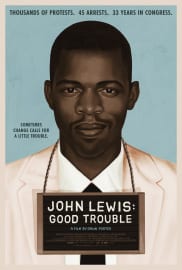Sometimes what is going on around us colors what we see when we watch a film. For example, today (I?m writing on January 6, 2021) I chose to watch the wonderful documentary John Lewis: Good Trouble. Part way through, my wife came out and told me to turn on the news, where a seditious mob was occupying the US Capitol. When I resumed the film, the seeming parallels were striking, but in reality, these stories diverge radically.

John Lewis, Baptist minister, civil rights leader, long time Congressman, spent his life in support of liberty. He was beaten on the Edmund Pettis Bridge in Selma. He was a Freedom Rider, beaten by the Klan in North Carolina. He took part in lunch counter sit-ins in Nashville. He was arrested over 40 times. His main focus in the civil rights movement was voting rights?the ability of all people to be able to vote freely. He understood the power of protest. He was also a strong believer in non-violence. He worked to make the world a better place for all people. His mantra when speaking to groups was that they should get in trouble, ?good trouble, necessary trouble?, to do what is right.
I would submit that what I saw on the news today was really quite different from the kind of ?good trouble? that John Lewis advocated. The protesters today claim they are there because the election was rigged, and they have been goaded on by the lies of President Trump. They are not being non-violent. They are doing damage. They are injuring others. Whereas John Lewis sought to bring light into the world, this group only brings darkness. Even after they have been denounced by members of both political parties, they continue their mayhem.

When the film I watched showed the events in Selma or other protests Lewis was involved in, the only violence was that which police or mobs used against the marchers. The Selma March was just that?people walking together along the side of the road. In sit-ins, the protesters did not do damage. They didn?t break the store windows or lunch counter equipment. They just asked to be served. (Lewis asked for a hamburger and a Coke.) Lewis and the others in the movement did not attack the institutions of government; they just asked to be able to transform government through the ballot.
Lewis understood what he was doing was a battle for the soul of America. The images on the news today make it very clear that that battle?which is as spiritual as it is political, continues. John Lewis was an optimist. (I think one had to have optimism to fight for Civil Rights.) His final message in the film, spoken directly to the camera, was ?We will create the beloved community. We will redeem the soul of America. There may be some setbacks, some delays, but as a nation and a people we will get there. And I still believe we shall overcome.?
Photos courtesy of Magnolia Pictures.





